Using Low-Cost Sensors for Measuring and Monitoring Particulate Matter with a Focus on Fine and Ultrafine Particles
Abstract
1. Introduction
2. Materials and Methods
2.1. Particulate Matter Sensors
- Budget (≤100€ per sensor),
- Availability on the market in Slovakia,
- Accuracy guaranteed by the manufacturer in the datasheet,
- The possibility to interface with a microcontroller board such as ESP8266, ESP32, or Arduino (I2C interface preferred),
- It was preferable that the sensors would be able to measure multiple sizes of PM mass and number concentrations and smaller (fine or ultrafine) particles,
- In the case of SPS30 and SEN54, sensors which can measure PM1/2.5/4/10 mass concentration and PM0.5/1/2.5/4/10 number concentration were preferred over sensors which can only measure PM2.5/10 mass concentration,
- In the case of IPS7100, the ability to measure PM0.1 and PM0.3 mass and number concentration were considered.
2.2. Measurement Systems
- Measurement system (#1) (Figure 4a) where SPS30 sensor was used for measuring PM, along with SHT30 for measuring temperature and humidity, MS5611 for measuring temperature and atmospheric pressure,
- Measurement system (#2) (Figure 4b) where the SEN54 sensor was used for measuring PM, VOC index, temperature, and humidity along with MS5611 for measuring temperature and atmospheric pressure,
- And measurement system (#3) (Figure 4c) where the IPS-7100 sensor was used for measuring PM, along with SHT30 for measuring temperature and humidity, and MS5611 for measuring temperature and atmospheric pressure.
2.3. Places of Measurement
- Košice #1—2nd largest city in Slovakia, the measurements were carried out outside the window on the 1st floor of the Department of Theoretical and Industrial Engineering (DTIEE), which is located at a university campus near the park. The nearest 4-lane road is located behind the park, 200 m from DTIEE.
- Košice #2—2nd measurement location in Košice is situated 2.4 km to the east of DTIEE and 13.8 km to the northeast of US Steel. The measurements were carried out on the balcony of an apartment on the 11th floor, which is situated 200 m from a 4-lane road.
- Košice #3—3rd measurement location in Košice is situated 2.7 km to the south of DTIEE. The measurements were carried out on the balcony of an apartment on the 5th floor, the balcony is facing towards the nearby park and away from the main road.
- Prešov—a family house located in the suburbs, the city is 30 km to the north of Košice. The family house is situated 30 m from the main road.
- Snina—apartment on the 3rd floor, the city is 72.6 km to the northeast of Košice. The apartment complex is situated 20 m from the main road.
- Habura—a Slovak village situated 80 km to the northeast of Košice, the measurements took place outside the window on the 1st floor of a family house, which is located on the side street that is not frequented by motor vehicles very often.
- Füzérkomlós—a Hungarian village situated 7 km away from the border with Slovakia and 28 km to the south-east of Košice. The measurements took place on the balcony on the 1st floor of a family house. There is a side street situated 15 m from the house.
- Valaliky—a Slovak village situated 11 km to the south of Košice; the measurements took place outside of a family house. The distance from the nearest road is 40 m.
- Zdoba—a Slovak village situated 11 km to the east of Košice; the measurements took place outside of a family house. The property of the house where the measurements took place is situated 50 m from the driveway.
2.4. Data Analysis
3. Results and Discussion
3.1. Measuring PM in Urban and Rural Areas Using SPS30 and SEN54
3.2. Measuring PM Using IPS-7100
4. Conclusions
Author Contributions
Funding
Institutional Review Board Statement
Informed Consent Statement
Data Availability Statement
Acknowledgments
Conflicts of Interest
References
- World Health Organization. Ambient and Outdoor Air Pollution. Key Facts. Available online: https://www.who.int/news-room/fact-sheets/detail/ambient-(outdoor)-air-quality-and-health (accessed on 30 May 2022).
- Kremler, M. Report on Air Quality in Slovak Republic in 2020. Available online: https://www.shmu.sk/File/oko/rocenky/2020_Air_Pollution_in_the_SR_v1.pdf (accessed on 27 December 2022).
- World Health Organization. WHO Global Air Quality Guidelines; World Health Organization: Geneva, Switzerland, 2021; Available online: https://apps.who.int/iris/bitstream/handle/10665/345329/9789240034228-eng.pdf (accessed on 27 December 2022).
- Hester, R.E. Airborne Particulate Matter: Sources, Atmospheric Processes and Health; Royal Society of Chemistry: Cambridge, UK, 2016; ISBN 978-1-78262-491-2. [Google Scholar]
- Bell, M.L.; HEI Health Review Committee. Assessment of the Health Impacts of Particulate Matter Characteristics. Res. Rep. Health. Eff. Inst. 2012, 161, 5–38. Available online: https://www.healtheffects.org/system/files/Bell-161.pdf (accessed on 30 May 2022).
- Lippmann, M. Toxicological and Epidemiological Studies of Cardiovascular Effects of Ambient Air Fine Particulate Matter (PM2.5) and Its Chemical Components: Coherence and Public Health Implications. Crit. Rev. Toxicol. 2014, 44, 299–347. [Google Scholar] [CrossRef]
- Adams, K.; Greenbaum, D.S.; Shaikh, R.; van Erp, A.M.; Russell, A.G. Particulate Matter Components, Sources, and Health: Systematic Approaches to Testing Effects. J. Air Waste Manag. Assoc. 2015, 65, 544–558. [Google Scholar] [CrossRef] [PubMed]
- Kampa, M.; Castanas, E. Human Health Effects of Air Pollution. Environ. Pollut. 2008, 151, 362–367. [Google Scholar] [CrossRef] [PubMed]
- Brook, R.D. Cardiovascular Effects of Air Pollution. Clin. Sci. 2008, 115, 175–187. [Google Scholar] [CrossRef]
- Bourdrel, T.; Bind, M.A.; Béjot, Y.; Morel, O.; Argacha, J.F. Cardiovascular Effects of Air Pollution. Arch. Cardiovasc. Dis. 2017, 110, 634–642. [Google Scholar] [CrossRef] [PubMed]
- Jo, E.J.; Lee, W.S.; Jo, H.Y.; Kim, C.H.; Eom, J.S.; Mok, J.H.; Kim, M.H.; Lee, K.; Kim, K.U.; Lee, M.K.; et al. Effects of Particulate Matter on Respiratory Disease and the Impact of Meteorological Factors in Busan, Korea. Respir. Med. 2017, 124, 79–87. [Google Scholar] [CrossRef]
- Pope, C.A.; Ezzati, M.; Dockery, D.W. Fine-Particulate Air Pollution and Life Expectancy in the United States. N. Engl. J. Med. 2009, 360, 376–386. [Google Scholar] [CrossRef]
- Gehring, U.; Gruzieva, O.; Agius, R.M.; Beelen, R.; Custovic, A.; Cyrys, J.; Eeftens, M.; Flexeder, C.; Fuertes, E.; Heinrich, J.; et al. Air Pollution Exposure and Lung Function in Children: The ESCAPE Project. Environ. Health Perspect. 2013, 121, 1357–1364. [Google Scholar] [CrossRef]
- Zhang, Y.; He, M.; Wu, S.; Zhu, Y.; Wang, S.; Shima, M.; Tamura, K.; Ma, L. Short-Term Effects of Fine Particulate Matter and Temperature on Lung Function among Healthy College Students in Wuhan, China. Int. J. Environ. Res. Public Health 2015, 12, 7777–7793. [Google Scholar] [CrossRef]
- Omori, T.; Fujimoto, G.; Yoshimura, I.; Nitta, H.; Ono, M. Effects of Particulate Matter on Daily Mortality in 13 Japanese Cities. J. Epidemiol. 2003, 13, 314–322. [Google Scholar] [CrossRef] [PubMed]
- Mühlfeld, C.; Rothen-Rutishauser, B.; Blank, F.; Vanhecke, D.; Ochs, M.; Gehr, P. Interactions of Nanoparticles with Pulmonary Structures and Cellular Responses. Am. J. Physiol.-Lung Cell. Mol. Physiol. 2008, 294, L817–L829. [Google Scholar] [CrossRef] [PubMed]
- Schraufnagel, D.E. The Health Effects of Ultrafine Particles. Exp. Mol. Med. 2020, 52, 311–317. [Google Scholar] [CrossRef]
- Kwoon, H.; Ryu, M.; Carlsten, C. Ultrafine particles: Unique physiochemical properties relevant to health and disease. Exp. Mol. Med. 2020, 52, 318–328. [Google Scholar] [CrossRef]
- Götschi, T.; Heinrich, J.; Sunyer, J.; Künzli, N. Long-Term Effects of Ambient Air Pollution on Lung Function: A Review. Epidemiology 2008, 19, 690–701. [Google Scholar] [CrossRef]
- Kyung, S.Y.; Jeong, S.H. Particulate-Matter Related Respiratory Diseases. Tuberc. Respir. Dis. 2020, 83, 116–121. [Google Scholar] [CrossRef]
- Slovak Hydrometeorologic Institute. Limit Values Eval. Air Qual. Available online: https://www.shmu.sk/sk/?page=1&id=oko_kriteria (accessed on 23 January 2023).
- Kim, M.J. Changes in the Relationship between Particulate Matter and Surface Temperature in Seoul from 2002–2017. Atmosphere 2019, 10, 238. [Google Scholar] [CrossRef]
- New Zealand Government. Natural Sources of Particulate Matter. Available online: https://www.stats.govt.nz/indicators/natural-sources-of-particulate-matter/ (accessed on 18 October 2022).
- Suleiman, A.; Tight, M.R.; Quinn, A.D. Assessment and Prediction of the Impact of Road Transport on Ambient Concentrations of Particulate Matter PM10. Transp. Res. Part D Transp. Environ. 2016, 49, 301–312. [Google Scholar] [CrossRef]
- Chafe, Z.; Brauer, M.; Héroux, M.E.; Klimont, Z.; Lanki, T.; Salonen, R.O.; Smith, K.R. Residential Heating with Wood and Coal: Health Impacts and Policy Options in Europe and North America; World Health Organization: Geneva, Switzerland, 2015; Available online: https://apps.who.int/iris/handle/10665/153671 (accessed on 18 January 2023).
- California Air Resources Board. Inhalable Particulate Matter and Health (PM2.5 and PM10). Available online: https://ww2.arb.ca.gov/resources/inhalable-particulate-matter-and-health (accessed on 31 January 2023).
- Ministry of Agriculture, Hungary. PM10 Reduction Programme-Resources and Factions. Available online: https://pm10.kormany.hu/forrasok (accessed on 31 January 2023).
- Air Quality Expert Group. Ultrafine Particles (UFP) in the UK, 2018. Available online: https://uk-air.defra.gov.uk/assets/documents/reports/cat09/1807261113_180703_UFP_Report_FINAL_for_publication.pdf (accessed on 31 January 2023).
- Moreno-Ríos, A.L.; Tejeda-Benítez, L.P.; Bustillo-Lecompte, C.F. Sources, Characteristics, Toxicity, and Control of Ultrafine Particles: An Overview. Geosci. Front. 2022, 13, 101147. [Google Scholar] [CrossRef]
- Shah, R.U.; Padilla, L.E.; Peters, D.R.; Dupuy-Todd, M.; Fonseca, E.R.; Ma, G.Q.; Popoola, O.A.; Jones, R.L.; Mills, J.; Martin, N.A.; et al. Identifying Patterns and Sources of Fine and Ultrafine Particulate Matter in London Using Mobile Measurements of Lung-Deposited Surface Area. Environ. Sci. Technol. 2023, 57, 96–108. [Google Scholar] [CrossRef]
- Arano-Martinez, J.A.; Martínez-González, C.L.; Salazar, M.I.; Torres-Torres, C. A Framework for Biosensors Assisted by Multiphoton Effects and Machine Learning. Biosensors 2022, 12, 710. [Google Scholar] [CrossRef]
- Tongprasert, P.; Ongsomwang, S. A Suitable Model for Spatiotemporal Particulate Matter Concentration Prediction in Rural and Urban Landscapes, Thailand. Atmosphere 2022, 13, 904. [Google Scholar] [CrossRef]
- Diviacco, P.; Iurcev, M.; Carbajales, R.J.; Potleca, N. First Results of the Application of a Citizen Science-Based Mobile Monitoring System to the Study of Household Heating Emissions. Atmosphere 2022, 13, 1689. [Google Scholar] [CrossRef]
- Kliengchuay, W.; Meeyai, A.C.; Worakhunpiset, S.; Tantrakarnapa, K. Relationships between Meteorological Parameters and Particulate Matter in Mae Hong Son Province, Thailand. Int. J. Environ. Res. Public Health 2018, 15, 2801. [Google Scholar] [CrossRef] [PubMed]
- Aldegunde, J.A.Á.; Sánchez, A.F.; Saba, M.; Bolaños, E.Q.; Palenque, J.Ú. Analysis of PM2.5 and Meteorological Variables Using Enhanced Geospatial Techniques in Developing Countries: A Case Study of Cartagena de Indias City (Colombia). Atmosphere 2022, 13, 506. [Google Scholar] [CrossRef]
- Li, C.; Huang, Y.; Guo, H.; Wu, G.; Wang, Y.; Li, W.; Cui, L. The Concentrations and Removal Effects of PM10 and PM2.5 on a Wetland in Beijing. Sustainability 2019, 11, 1312. [Google Scholar] [CrossRef]
- Wang, J.; Ogawa, S. Effects of Meteorological Conditions on PM2.5 Concentrations in Nagasaki, Japan. Int. J. Environ. Res. Public Health 2015, 12, 9089–9101. [Google Scholar] [CrossRef]
- Sirithian, D.; Thanatrakolsri, P. Relationships between Meteorological and Particulate Matter Concentrations (PM2.5 and PM10) during the Haze Period in Urban and Rural Areas, Northern Thailand. Air Soil Water Res. 2022, 15, 11786221221117264. [Google Scholar] [CrossRef]
- Luo, H.; Zhou, W.; Jiskani, I.M.; Wang, Z. Analyzing Characteristics of Particulate Matter Pollution in Open-Pit Coal Mines: Implications for Green Mining. Energies 2021, 14, 2680. [Google Scholar] [CrossRef]
- Tai, A.P.K.; Mickley, L.J.; Jacob, D.J. Correlations between Fine Particulate Matter (PM2.5) and Meteorological Variables in the United States: Implications for the Sensitivity of PM2.5 to Climate Change. Atmos. Environ. 2010, 44, 3976–3984. [Google Scholar] [CrossRef]
- Yang, H.; Peng, Q.; Zhou, J.; Song, G.; Gong, X. The Unidirectional Causality Influence of Factors on PM2.5 in Shenyang City of China. Sci. Rep. 2020, 10, 8403. [Google Scholar] [CrossRef]
- Hernandez, G.; Berry, T.-A.; Wallis, S.L.; Poyner, D. Temperature and Humidity Effects on Particulate Matter Concentrations in a Sub-Tropical Climate During Winte. Int. Proc. Chem. Biol. Environ. Eng. 2017, 32, 57–64. [Google Scholar] [CrossRef]
- Jiang, B.; Sun, C.; Mu, S.; Zhao, Z.; Chen, Y.; Lin, Y.; Qiu, L.; Gao, T. Differences in Airborne Particulate Matter Concentration in Urban Green Spaces with Different Spatial Structures in Xi’an, China. Forests 2022, 13, 14. [Google Scholar] [CrossRef]
- Liu, Y.; Zhou, Y.; Lu, J. Exploring the Relationship between Air Pollution and Meteorological Conditions in China under Environmental Governance. Sci. Rep. 2020, 10, 14518. [Google Scholar] [CrossRef] [PubMed]
- Štrbová, K.; Raclavská, H.; Bílek, J. Impact of Fugitive Sources and Meteorological Parameters on Vertical Distribution of Particulate Matter over the Industrial Agglomeration. J. Environ. Manag. 2017, 203, 1190–1198. [Google Scholar] [CrossRef] [PubMed]
- Kirešová, S.; Guzan, M.; Galajda, P. Measuring Particulate Matter (PM) Using SPS30. In 32nd International Conference Radioelektronika; IEEE: Košice, Slovakia, 2022; pp. 160–165. [Google Scholar] [CrossRef]
- Kirešová, S.; Guzan, M. Determining the Correlation between Particulate Matter PM10 and Meteorological Factors. Eng 2022, 3, 343–363. [Google Scholar] [CrossRef]
- Sensirion. Particulate Matter Sensor for Air Quality Monitoring and Control. Datasheet SPS30. Available online: https://cdn.sos.sk/productdata/98/89/92718144/sps30-2.pdf (accessed on 30 May 2022).
- Sensirion. Environmental Sensor Node for HVAC and Air Quality Applications, SEN5x Datasheet. Available online: https://cdn.sparkfun.com/assets/5/b/f/2/8/Sensirion_Datasheet_SEN5x.pdf (accessed on 30 May 2022).
- Piera Systems. IPS Series Sensor 305/3100/525/5100/7100: Photon Counting Intelligent Particle Sensor for Accurate Air Quality Monitoring. Available online: https://www.farnell.com/datasheets/3749927.pdf (accessed on 22 December 2022).
- Amaral, S.S.; de Carvalho, J.A.; Costa, M.A.M.; Pinheiro, C. An Overview of Particulate Matter Measurement Instruments. Atmosphere 2015, 6, 1327–1345. [Google Scholar] [CrossRef]
- Lowther, S.D.; Jones, K.C.; Wang, X.; Whyatt, J.D.; Wild, O.; Booker, D. Particulate Matter Measurement Indoors: A Review of Metrics, Sensors, Needs, and Applications. Environ. Sci. Technol. 2019, 53, 11644–11656. [Google Scholar] [CrossRef] [PubMed]
- Kirešová, S.; Guzan, M. Measurement of Particulate Matter: Principles and Options of Measurement at Present. Acta Electrotech. Et Inform. 2022, 22, 8–18. [Google Scholar] [CrossRef]
- Slovak Hydrometeorological Institute. Monthly Reports. Available online: https://www.shmu.sk/sk/?page=1&id=oko_mes_s (accessed on 1 February 2023).
- Slovak Hydrometeorological Institute. Report on Air Quality in Slovak Republic in 2021: Appendix A-Measuring Stations of Air Quality Monitoring Networks–2021. Available online: https://www.shmu.sk/File/oko/rocenky/2021_Priloha_A.pdf (accessed on 1 February 2023).
- Slovak Hydrometeorological Institute. Average Daily Concentrations of Pollutants in October 2022. Available online: https://www.shmu.sk/File/oko/mesacne_spravy/10_2022_mesacne_hlasenie_v1.pdf (accessed on 1 February 2023).
- Slovak Hydrometeorological Institute. Average Daily Concentrations of Pollutants in November 2022. Available online: https://www.shmu.sk/File/oko/mesacne_spravy/11_2022_mesacne_hlasenie.pdf (accessed on 1 February 2023).
- Slovak Hydrometeorological Institute. Average Daily Concentrations of Pollutants in December 2022. Available online: https://www.shmu.sk/File/oko/mesacne_spravy/12_2022_mesacne_hlasenie.pdf (accessed on 1 February 2023).
- Slovak Hydrometeorological Institute. Average Daily Concentrations of Pollutants in February 2022. Available online: https://www.shmu.sk/File/oko/mesacne_spravy/02_2022_mesacne_hlasenie.pdf (accessed on 1 February 2023).
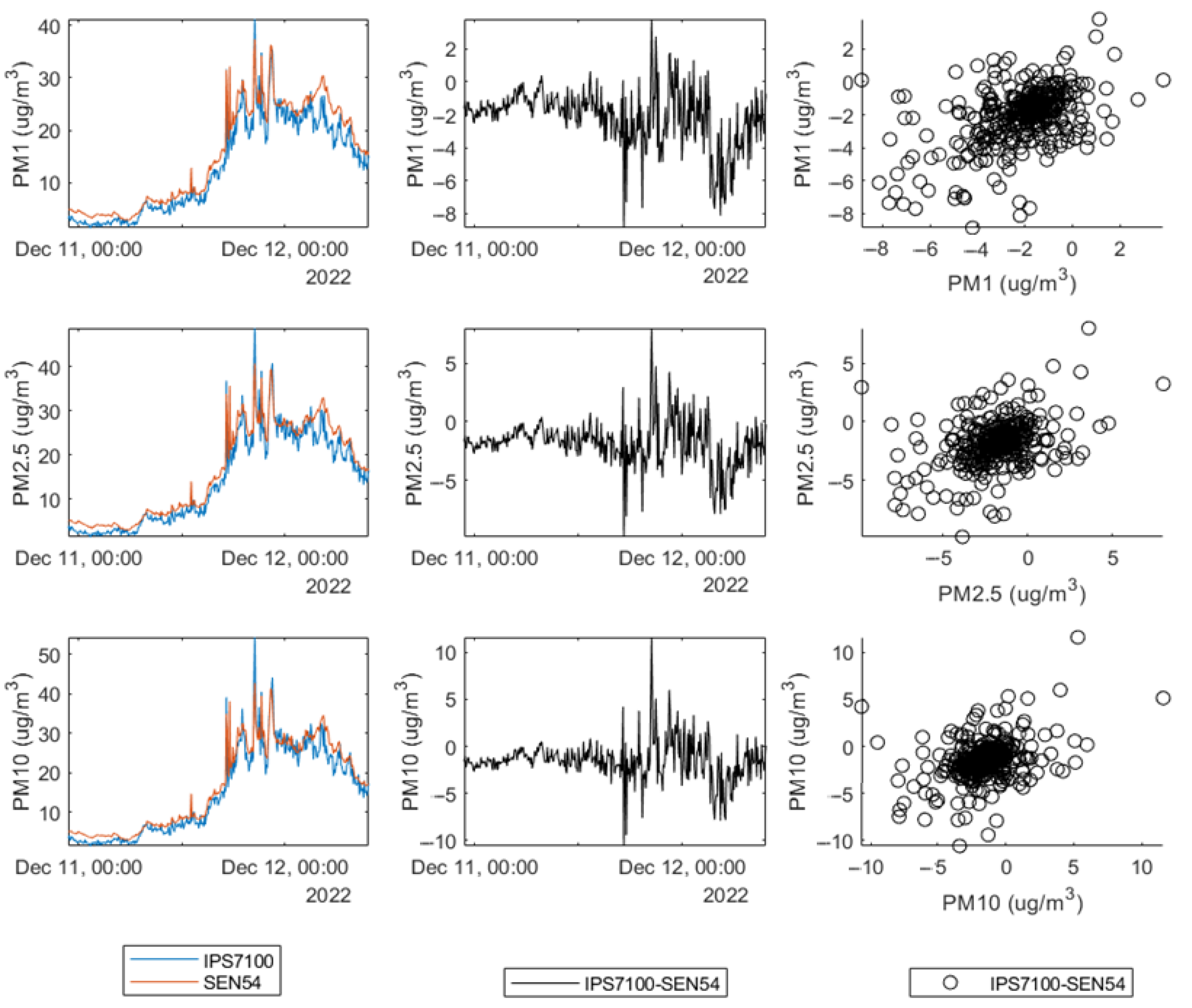
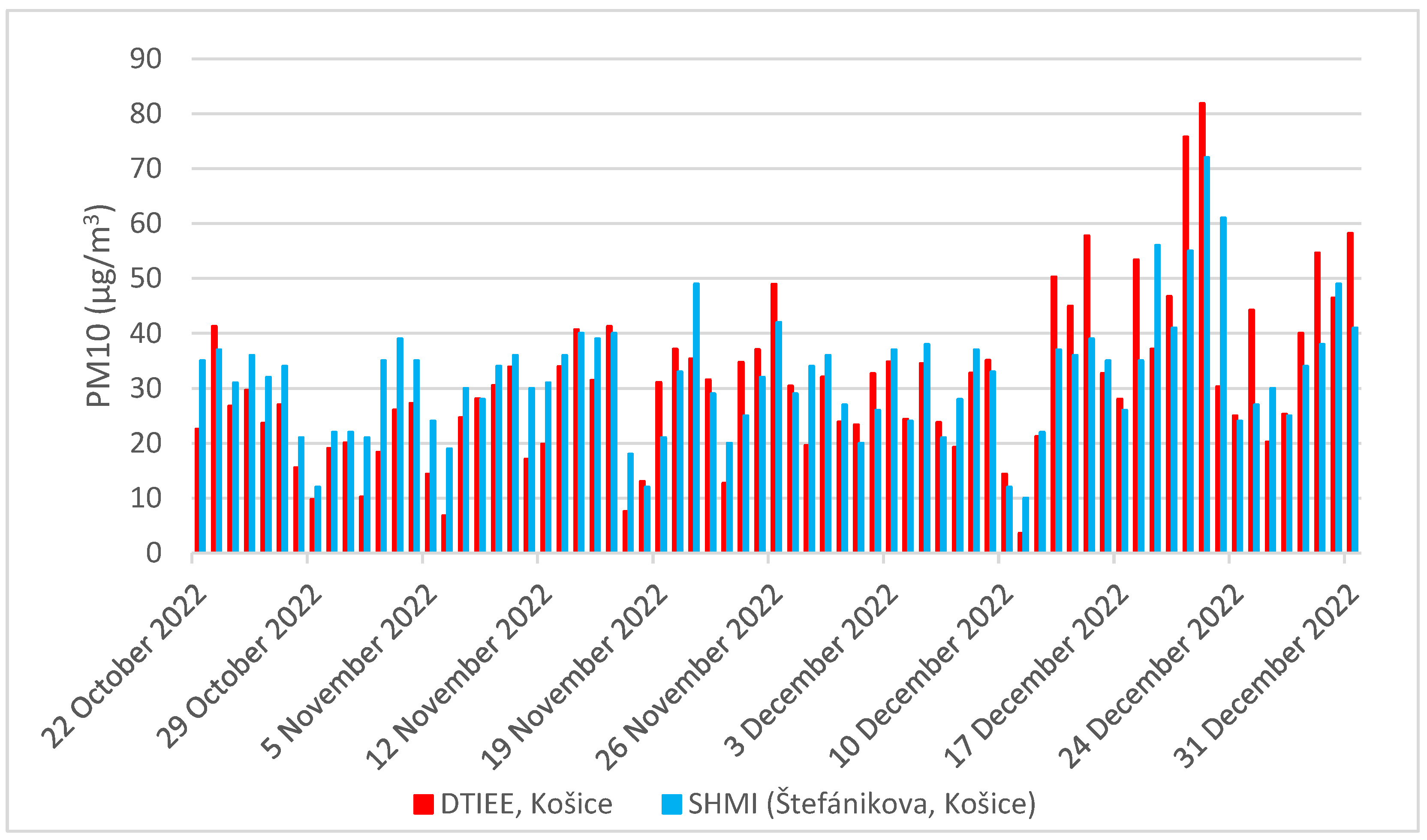

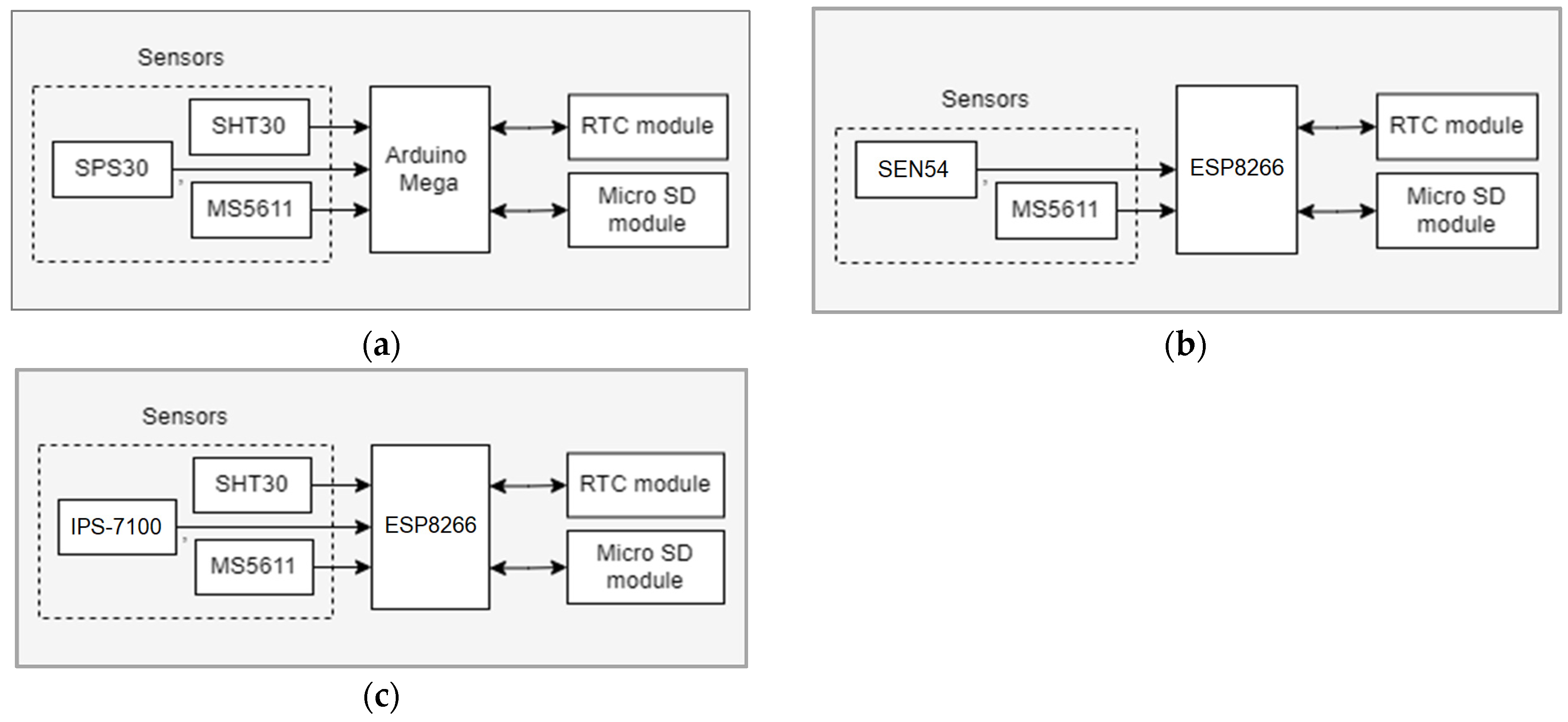

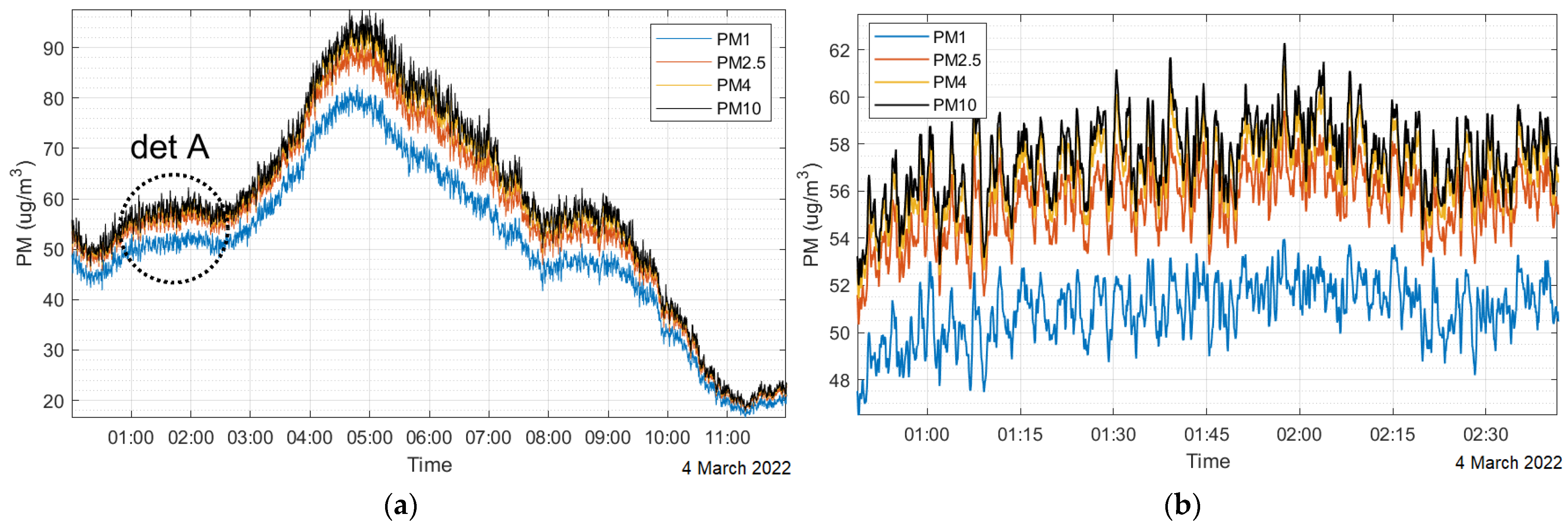
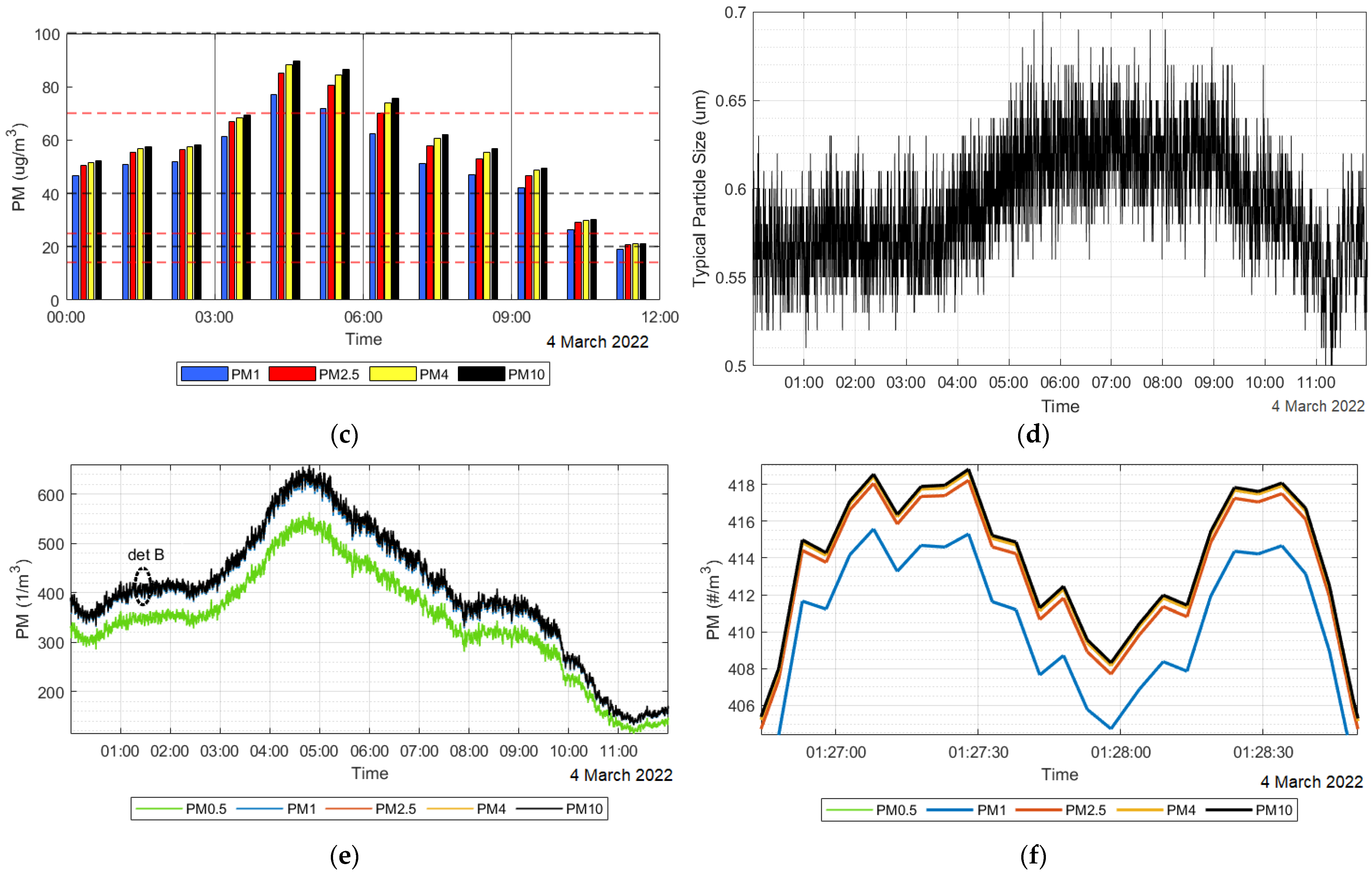
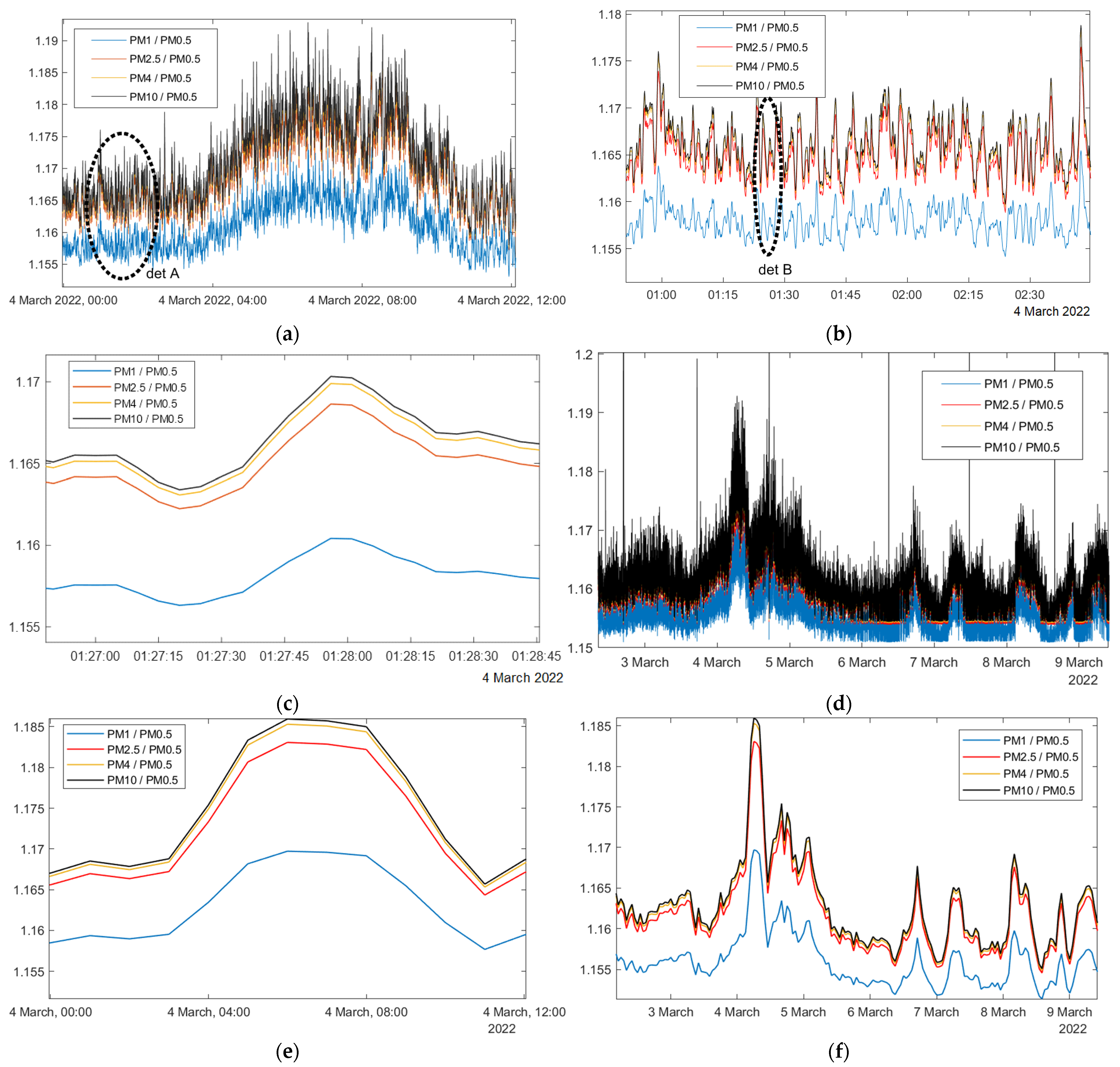
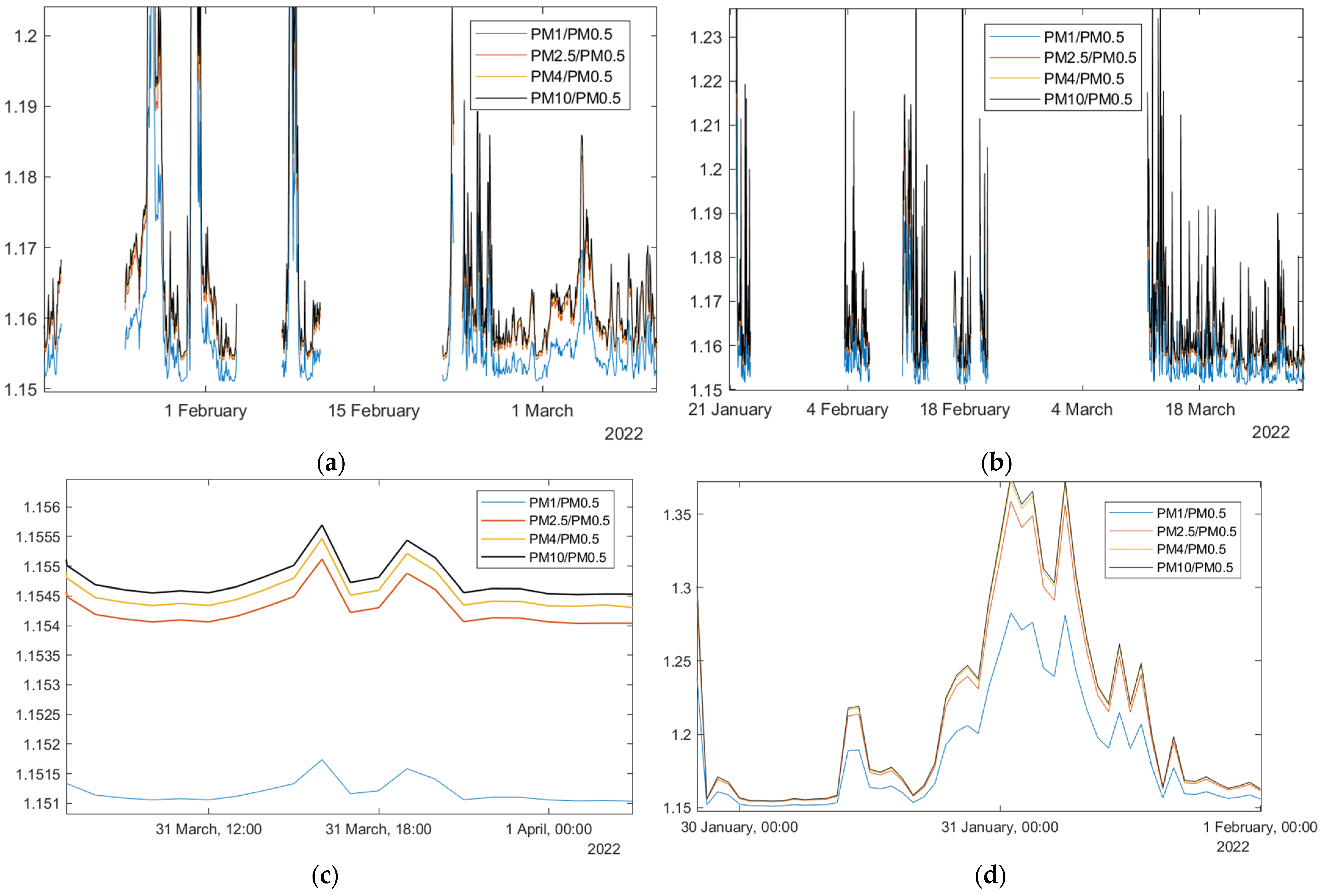

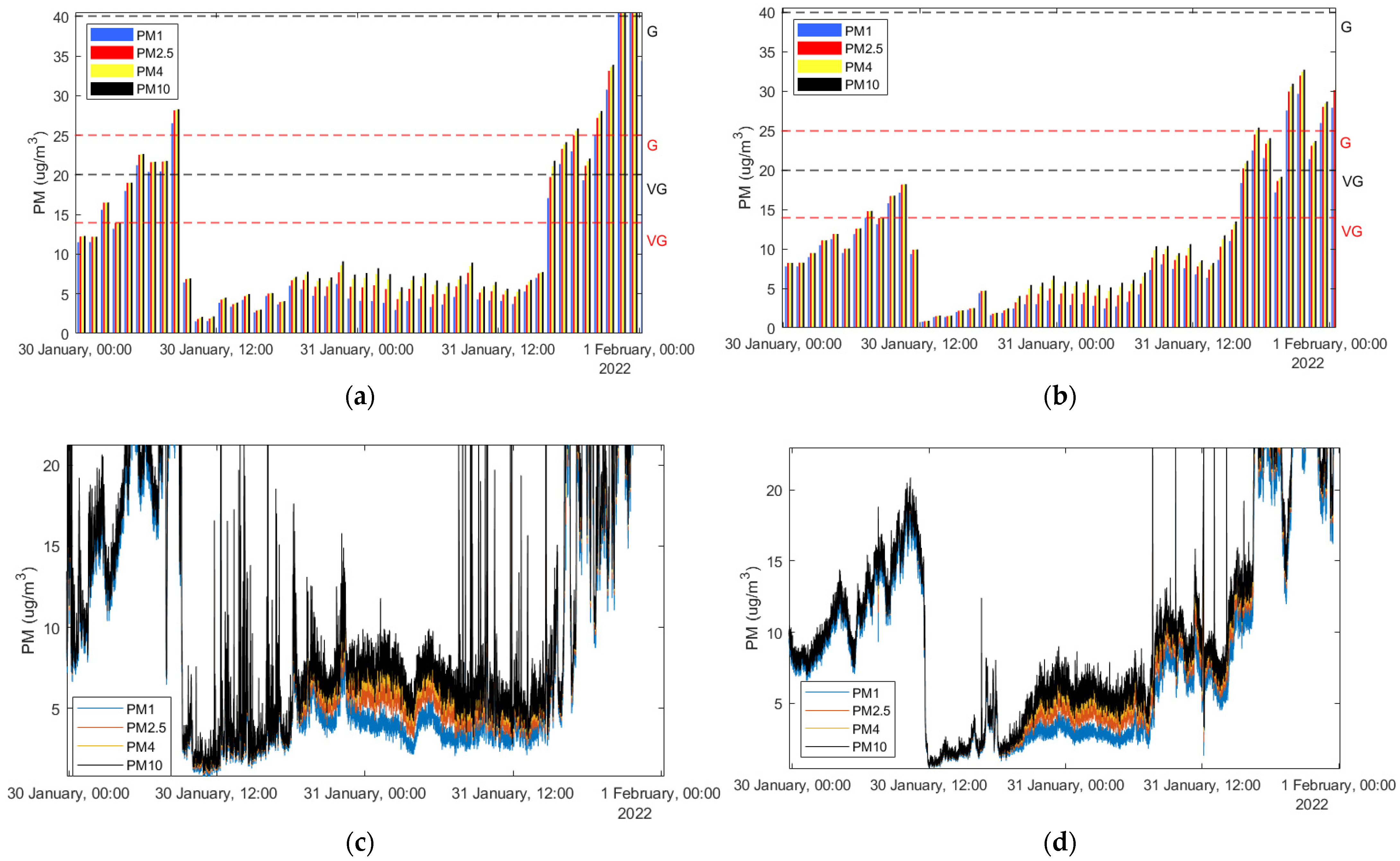
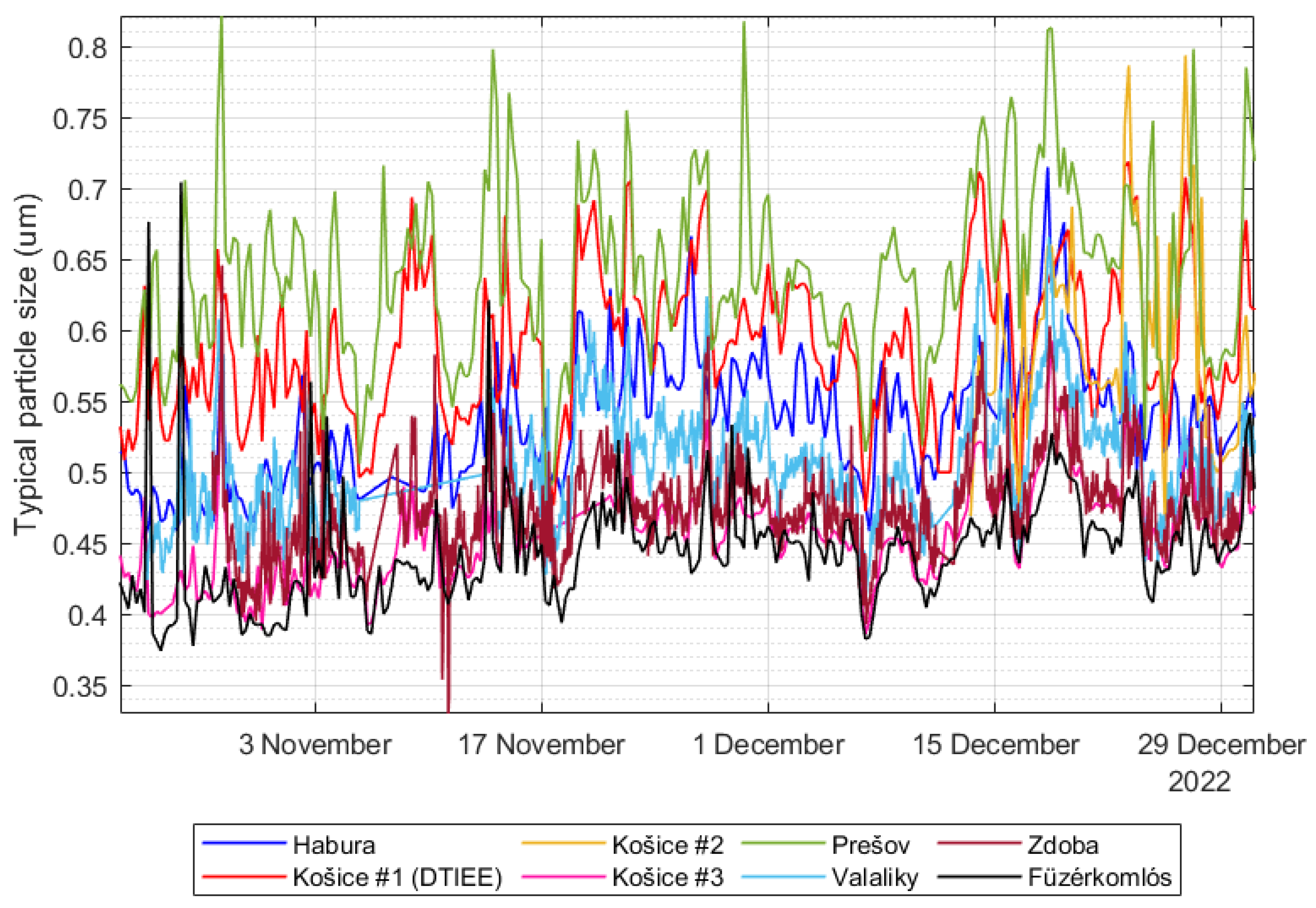
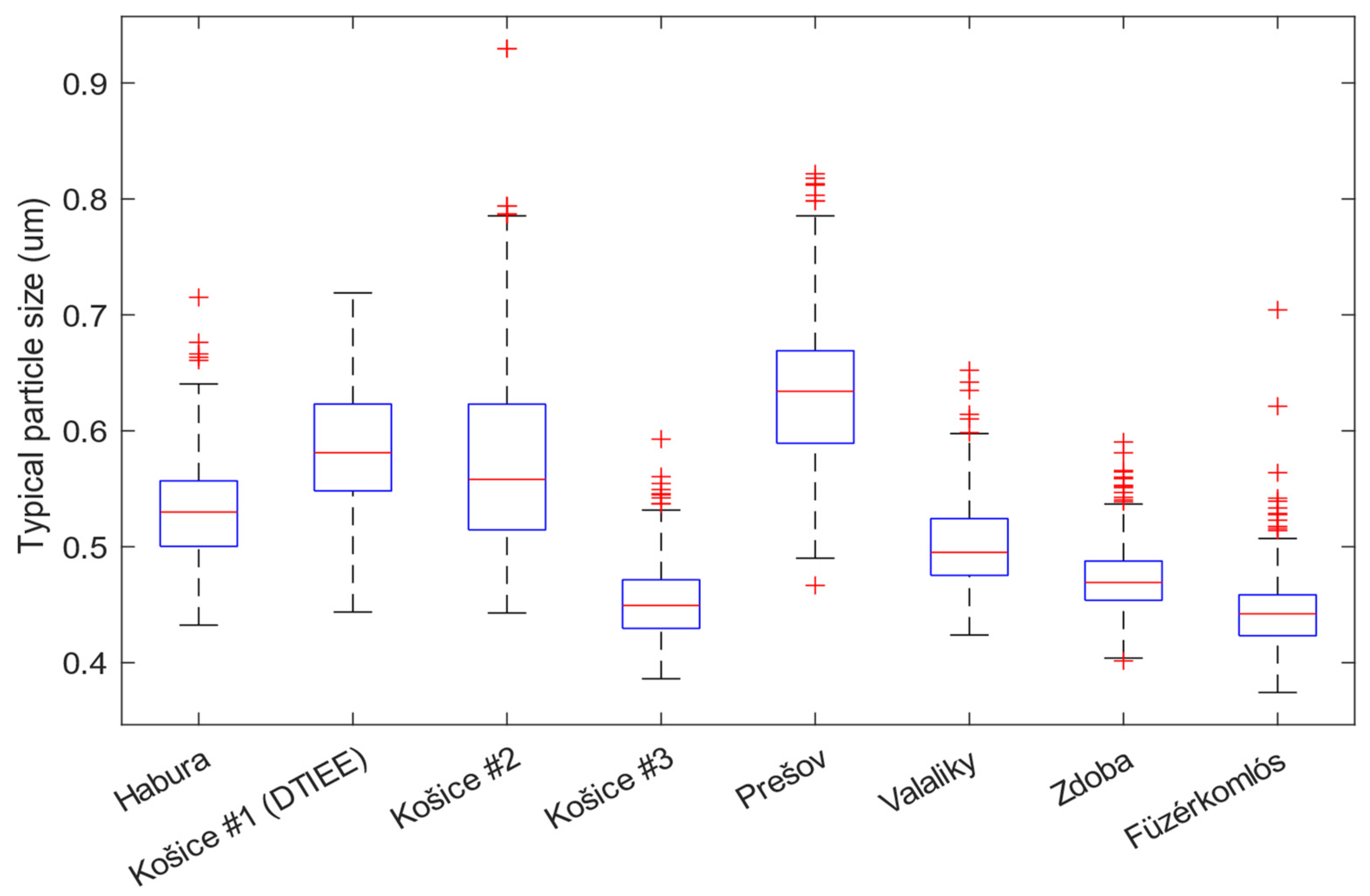
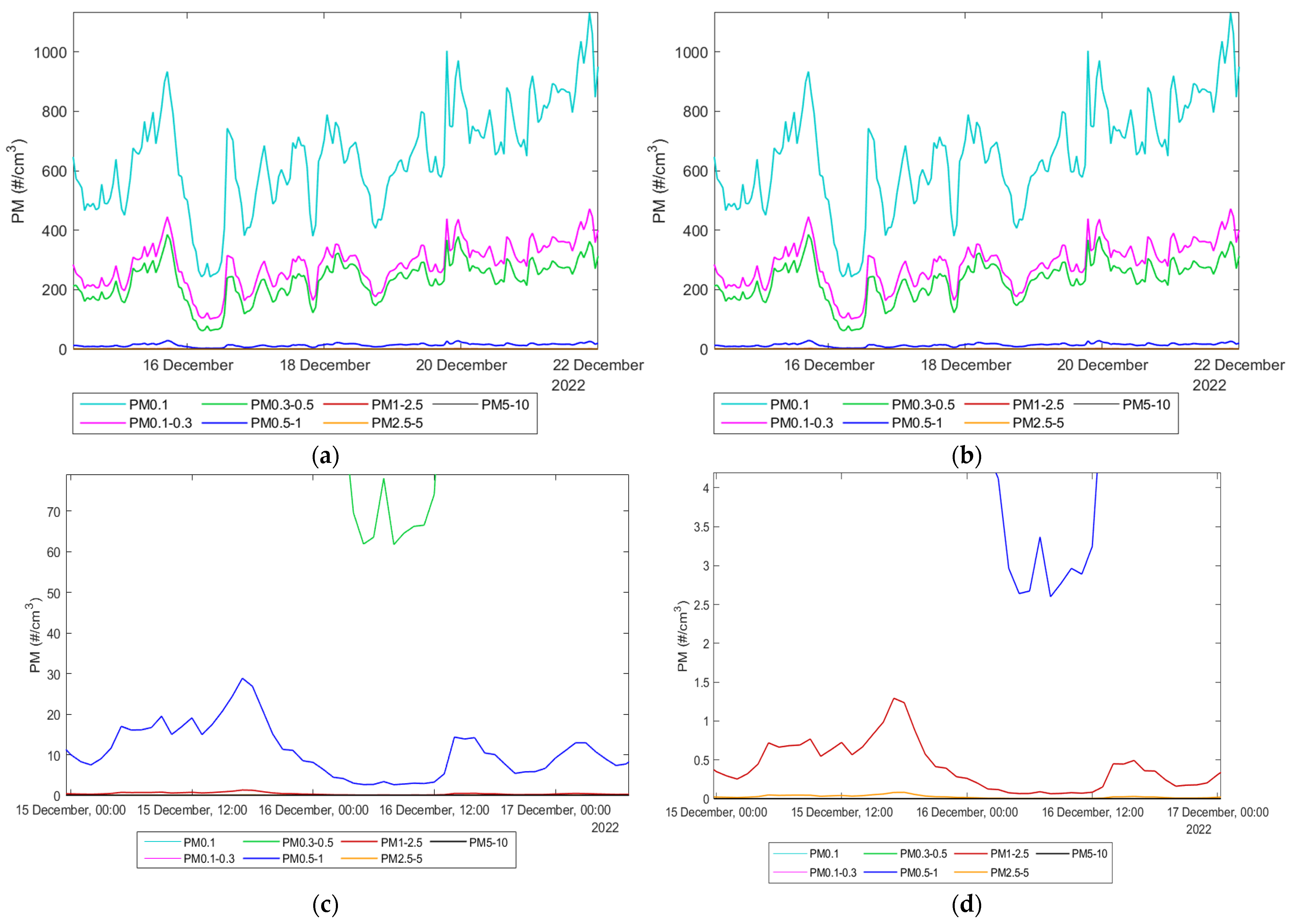
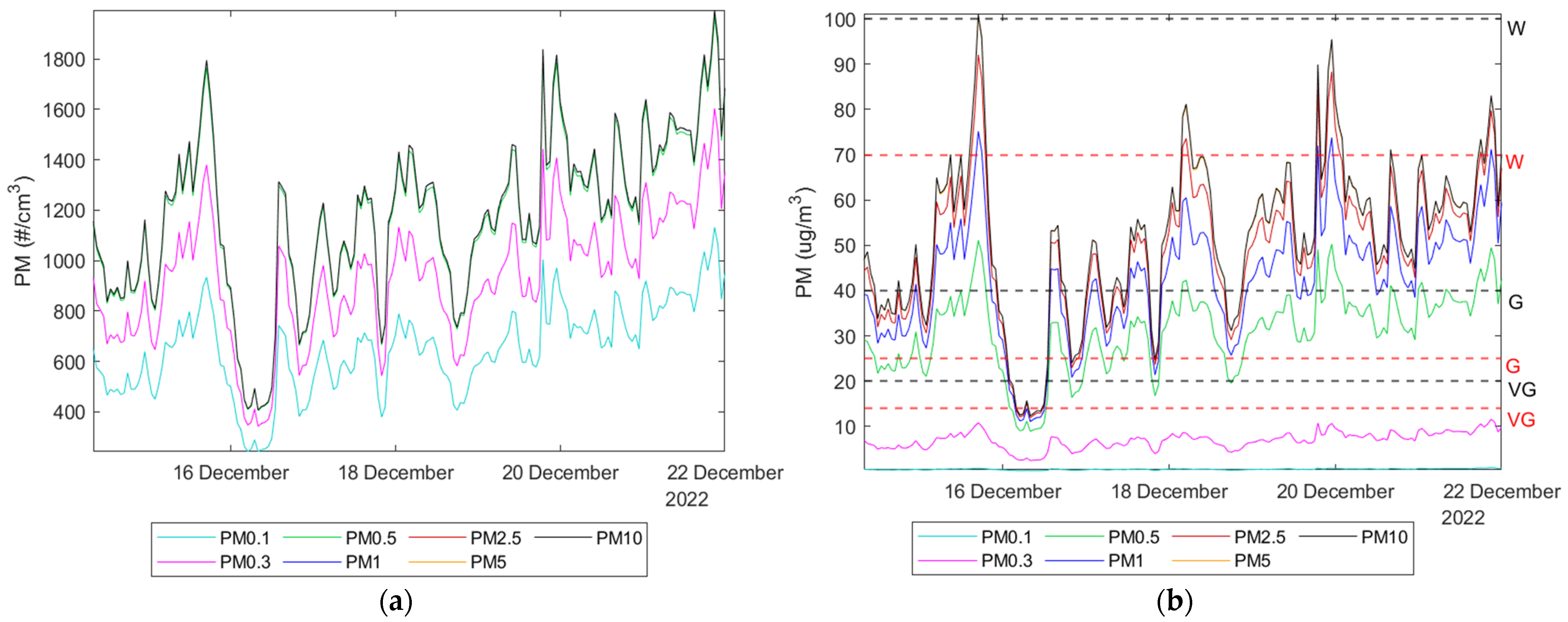

| Mass Concentration | Conditions | Accuracy |
|---|---|---|
| PM1, PM2.5 | 0–100 µg/m3 | ±10 µg/m3 |
| 100–1000 µg/m3 | ±10% | |
| PM4, PM10 | 0–100 µg/m3 | ±25 µg/m3 |
| 100–1000 µg/m3 | ±25% |
| Mass Concentration | Conditions | Accuracy |
|---|---|---|
| PM1, PM2.5 | 0–100 µg/m3 | ±(5 µg/m3 + 5%) |
| 100–1000 µg/m3 | ±10% | |
| PM4, PM10 | 0–100 µg/m3 | ±25 µg/m3 |
| 100–1000 µg/m3 | ±25% |
| Measuring Site | Interquartile Range (µm) | Median (µm) | Min. (µm) | Max. (µm) |
|---|---|---|---|---|
| Habura | 0.50–0.55 | 0.53 | 0.43 | 0.72 |
| Košice #1 DTIEE | 0.55–0.62 | 0.58 | 0.44 | 0.72 |
| Košice #2 | 0.51–0.62 | 0.56 | 0.44 | 0.92 |
| Košice #3 | 0.43–0.47 | 0.44 | 0.39 | 0.59 |
| Prešov | 0.59–0.67 | 0.63 | 0.47 | 0.82 |
| Valaliky | 0.48–0.52 | 0.50 | 0.42 | 0.65 |
| Zdoba | 0.45–0.49 | 0.47 | 0.40 | 0.59 |
| Füzérkomlós | 0.42–0.46 | 0.44 | 0.37 | 0.70 |
Disclaimer/Publisher’s Note: The statements, opinions and data contained in all publications are solely those of the individual author(s) and contributor(s) and not of MDPI and/or the editor(s). MDPI and/or the editor(s) disclaim responsibility for any injury to people or property resulting from any ideas, methods, instructions or products referred to in the content. |
© 2023 by the authors. Licensee MDPI, Basel, Switzerland. This article is an open access article distributed under the terms and conditions of the Creative Commons Attribution (CC BY) license (https://creativecommons.org/licenses/by/4.0/).
Share and Cite
Kirešová, S.; Guzan, M.; Sobota, B. Using Low-Cost Sensors for Measuring and Monitoring Particulate Matter with a Focus on Fine and Ultrafine Particles. Atmosphere 2023, 14, 324. https://doi.org/10.3390/atmos14020324
Kirešová S, Guzan M, Sobota B. Using Low-Cost Sensors for Measuring and Monitoring Particulate Matter with a Focus on Fine and Ultrafine Particles. Atmosphere. 2023; 14(2):324. https://doi.org/10.3390/atmos14020324
Chicago/Turabian StyleKirešová, Simona, Milan Guzan, and Branislav Sobota. 2023. "Using Low-Cost Sensors for Measuring and Monitoring Particulate Matter with a Focus on Fine and Ultrafine Particles" Atmosphere 14, no. 2: 324. https://doi.org/10.3390/atmos14020324
APA StyleKirešová, S., Guzan, M., & Sobota, B. (2023). Using Low-Cost Sensors for Measuring and Monitoring Particulate Matter with a Focus on Fine and Ultrafine Particles. Atmosphere, 14(2), 324. https://doi.org/10.3390/atmos14020324








